A late-July hike to Mt. Elly, south of Teton Pass, is an adventure through fields of wildflowers.
This post is in cooperation with the Wyoming Wilderness Association. (https://www.wildwyo.org/ ) which promotes the preservation of Wyoming’s wild lands. Peggie dePasquale, Associate Director, asked us to lead a group wildflower hike into the Palisades Wilderness Study Area at the end of July; however, due to concerns of Covid 19, we decided it was best not to be crowding around to view intriguing plants.
The following post encourages you to get out to see the flowers now along Teton Pass and other trails at similar elevations both in the Palisades WSA and elsewhere. Many, if not most, of the flowers will be the same. And they will keep on blooming at higher elevations or in cooler sites over the next couple of weeks.
The mile-and-a-half hike south from Teton Pass to Mt. Elly gently rises from 8,400’ to 9,200’ in elevation. The trail takes you across moist and dry mountain meadows covered in perennial wildflowers, through the dense shade of older growth Engelmann spruce and subalpine fir forests where fewer flowers persist, and to a south facing prominence dominated by sagebrush. At the end of the trail before it descends into Black Canyon, you can take in the expansive view south into the Palisades Wilderness Study Area (WSA).
The WSA is one half of the Greater Palisades Area that encompasses a quarter of a million acres of wild and untrammeled land. To learn more about the management challenges that surround the Palisades check out the website for the WWA film, PalisdesProject.org.
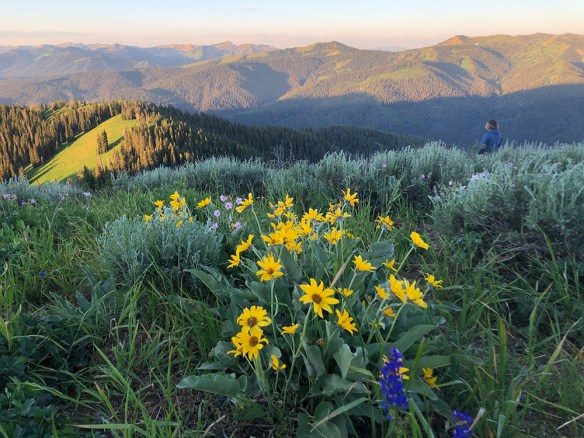 {photo by Peggy dePasquale, WWA)
{photo by Peggy dePasquale, WWA)
On to Trees, Shrubs, and Wildflowers!
The following plants are organized more or less in the order of appearance. Most can be seen within the first half-mile to the junction with the cell tower. Numbers on the map by Susan Marsh helps to orient you:
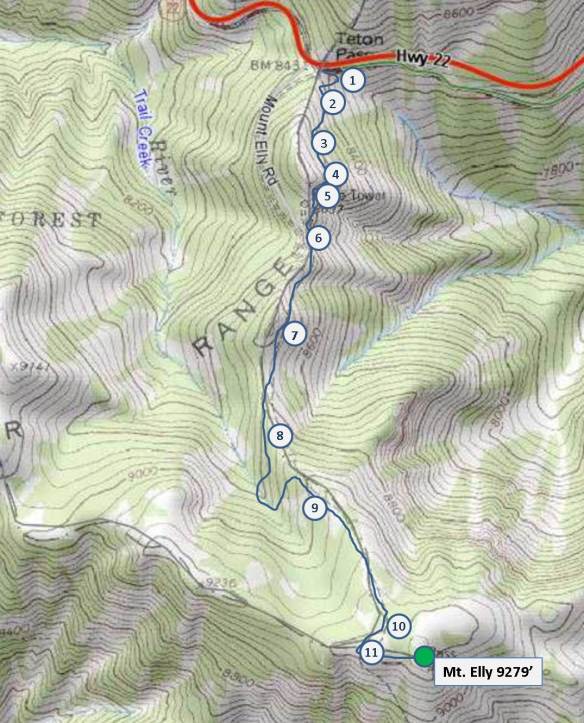
Along with the photos, descriptions are meant to be helpful in identifying species. At the end of each is a rating of “relative frequency” for this trail: R-Rare, O-Occasional, F-Frequent – C-Common, A-Abundant, LA – Locally Abundant e.g. a plentiful in only one or two places.
Here is a diagram of the basic flower parts to help you to see and identify the flowers – fun puzzles! (image from greenandvibrant.com)
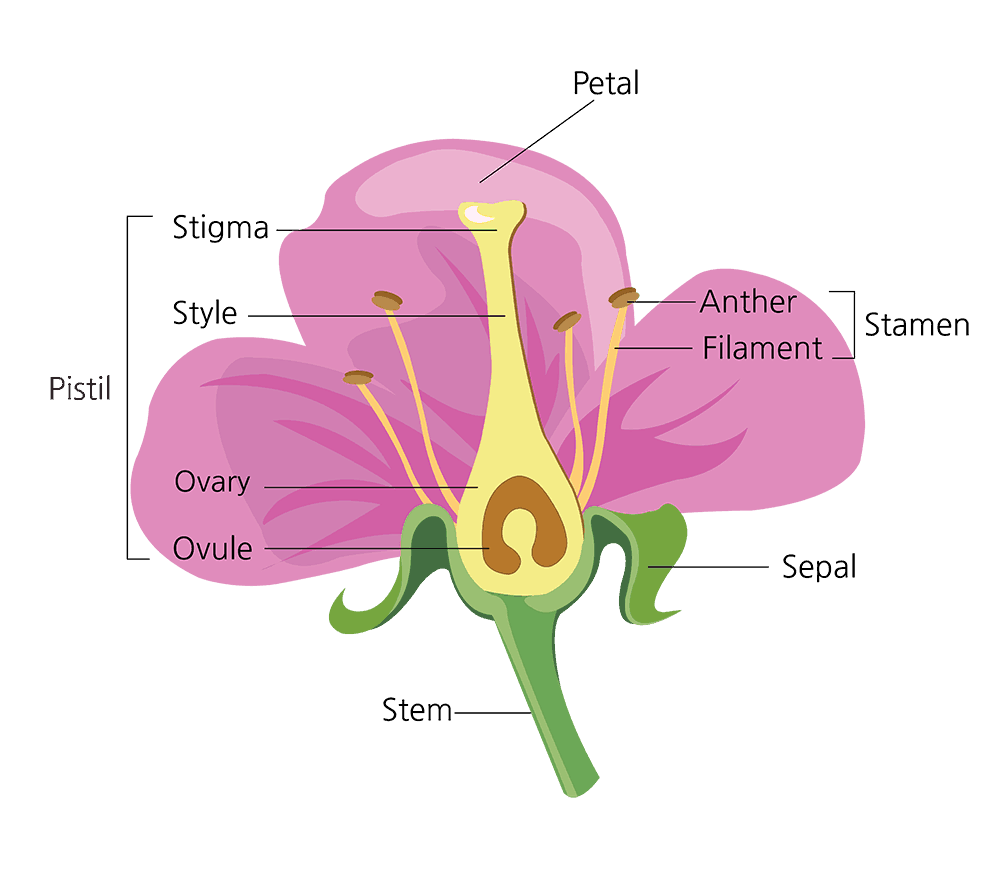
1.To start, climb up the trail (not the access road) through large old trees:
You will see two very large trees with flaking bark, Engelmann Spruce – Picea engelmannii. It has square, pointed, stiff needles that sit on little pegs. These sharp needles are typical of spruce. Cones dangle down and stay intact. They are often stashed by red squirrels for their winter food supply. O
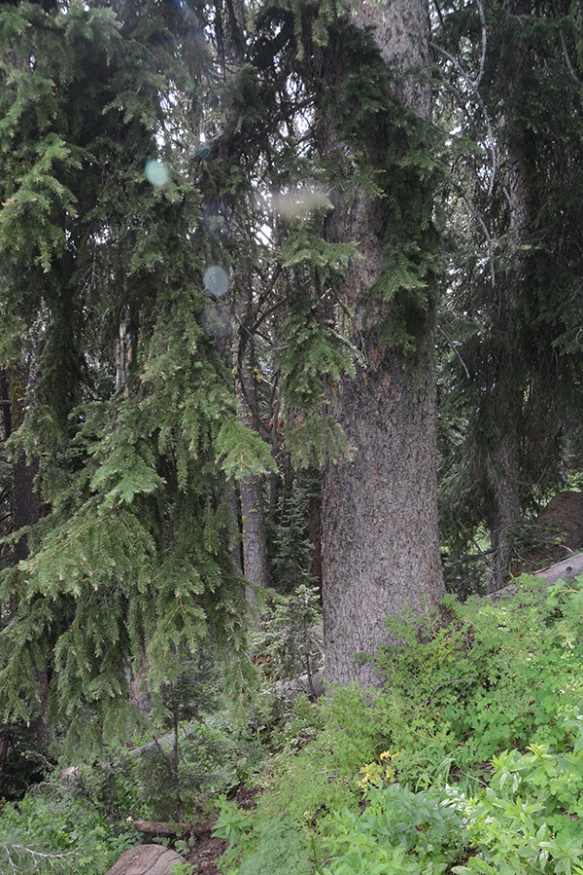
Look for 3 small trunks at the bend in the trail that are mostly gray and smooth with horizontal lines of bumps. These are Subalpine Firs – Abies lasciocarpa. The bumps are filled with a sticky resin that helps defend the tree from boring predators. The resin has been used by humans for sealing seams of canoes. The wood is brittle and used for light construction. The individual needles are flat, blunt, and feel soft. They are “friendly firs.” Cones stand up on the upper branches and the scales and seeds will fall off when they ripen in the fall.
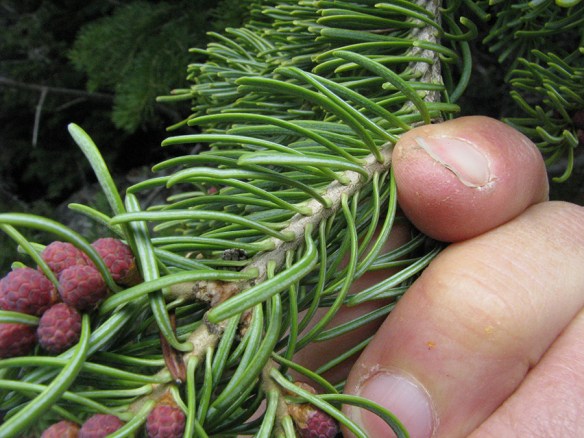 These two tree species are stalwarts of the higher elevation “spruce/fir” forests seen around Jackson Hole and south into the Snake River Range of the Palisades WSA. They grow where there is sufficient moisture/snow.
These two tree species are stalwarts of the higher elevation “spruce/fir” forests seen around Jackson Hole and south into the Snake River Range of the Palisades WSA. They grow where there is sufficient moisture/snow.
In the understory are several large 6-10’ shrubs of Mountain Ash – Sorbus scoparia. The leaves are divided into shiny leaflets arranged along a central stalk—”pinnately divided”. These “compound” leaves alternate along the woody stem. The sprays of small white flowers are fading and will produce bunches of red-orange berries in the fall that are relished by bears, small mammals, and birds. 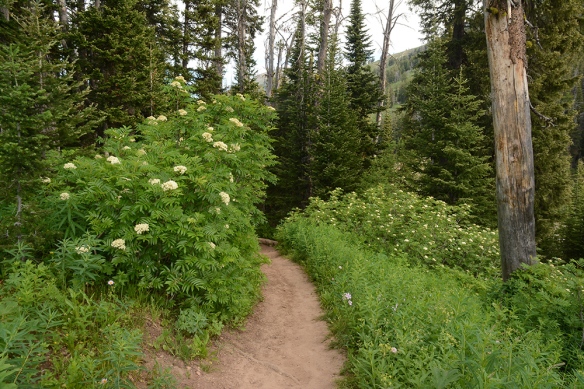
2. As you step out into the sunny slope, you will see several of the most common species found in mountain meadows. A combination of harsh winds and a late-growing season makes it hard for trees to survive. Herbaceous perennials use food stored in roots and underground stems to shoot up fast when the snow melts. New leaves take advantage of the long days of our short summers. It is amazing how such abundant biomass is produced each summer from bare ground.
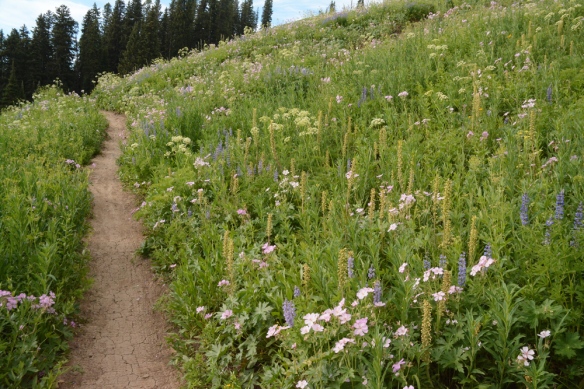 Fern-leaf Lovage – Ligusticum filicinum – Tall 3-4’ plants hold up clusters of lacey white flowers. Leaves are finely dissected and skirt the stems to 2-3’. Abundant in montane parks and aspen groves. The shaggy thick fragrant roots have been used medicinally by Native Americans. C
Fern-leaf Lovage – Ligusticum filicinum – Tall 3-4’ plants hold up clusters of lacey white flowers. Leaves are finely dissected and skirt the stems to 2-3’. Abundant in montane parks and aspen groves. The shaggy thick fragrant roots have been used medicinally by Native Americans. C 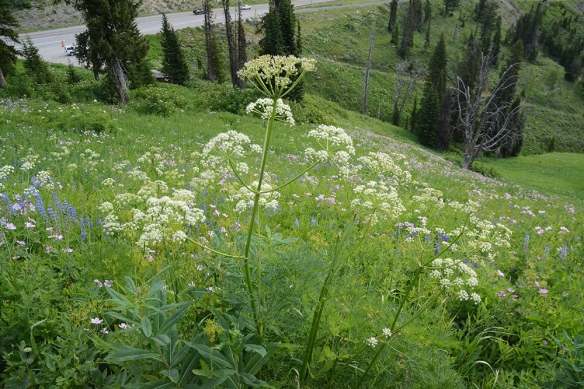
Lovage is just one of several members of the Parsley or Carrot Family – Apiaceae – seen on this trail. The tiny 5-parted flowers are held up in umbels. Umbels arise from a single point, like ribs to an umbrella. The dry fruits are schizocarps, which split in half. Often the fruits and/or foliage are fragrant. Leaves are usually dissected – think carrots and parsley. This family includes cumin, anise, dill, and several other fragrant herbs. Many have been used medicinally.
Western Sweetroot – Osmorhiza occidentalis – is a 2-3’ tall member of the Parsley Family. The delicate umbels of tiny green-yellow flowers are now forming 1” elongated, licorice-flavored fruits—have a taste! Sweetroot is fruiting at the beginning of the trail, but flowering farther along. The compound leaves look like those of its relative celery. Meadows and open forests. C
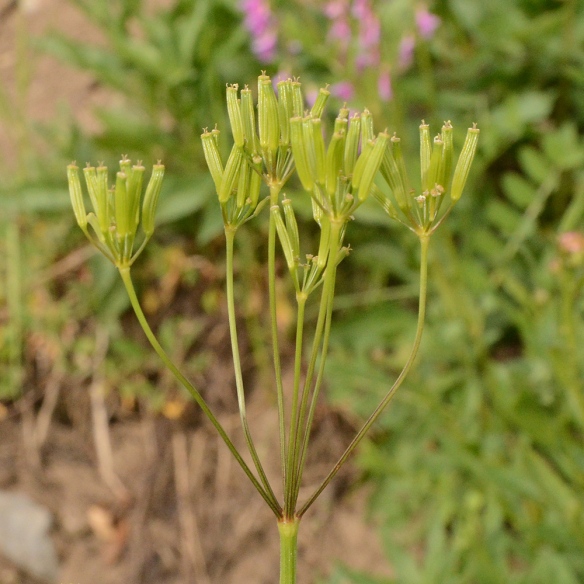
The ever popular Sticky Geranium – Geranium viscosissimum – is one of the most common and persistent flowers seen right now. Note the 5 pink petals with nectar guides converging on the center which attract many insects to pollinate the flowers. A bit later the dried fruits will catapult the seeds to new ground. The sticky hairs trap and can actually absorb nutrients from tiny insects. A
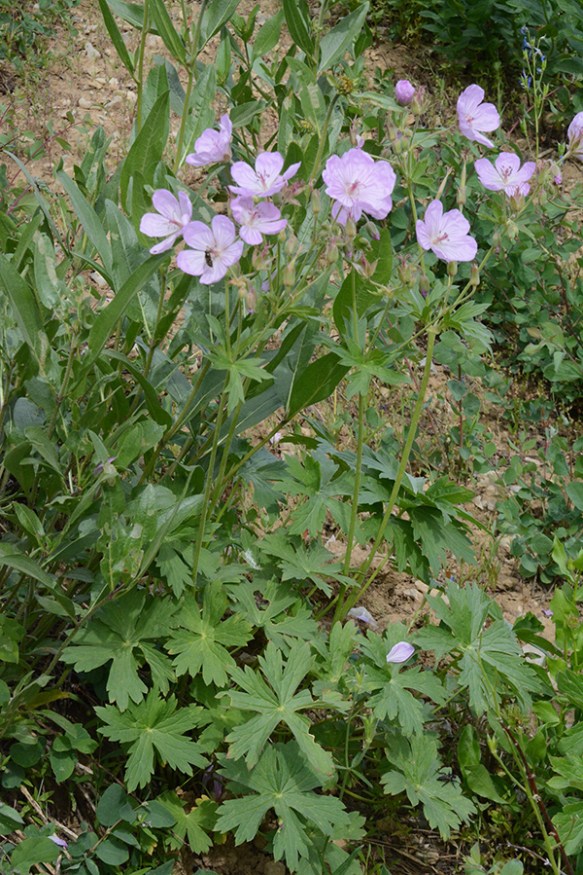
Silvery Lupine – Lupinus argenteus – is the common lupine of montane meadows and forests (vs. Silky Lupine – L. sericeus – of dry sage flats). A member of the Pea Family, it has stalks of many fragrant small blue pea-like flowers. The upright back of the flower, called the “banner”, is smooth (vs hairy in the Silky Lupine). Like all lupines, the leaves are palmately divided. Also, lupines can fix nitrogen with the aid of bacteria in their roots, and it is often the host for semi-parsitic paintbrushes. C
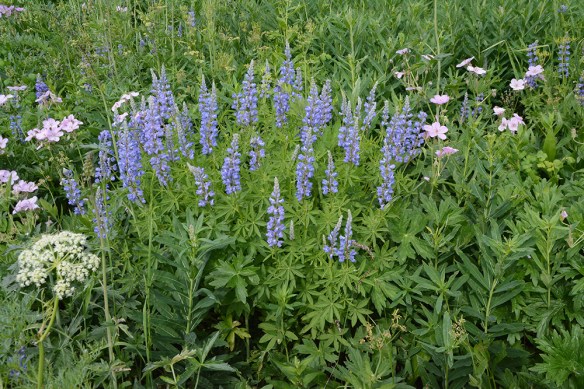
Blue Flax – Linum lewisii – 5-petaled flowers face up to capture the blue of the sky. The leaves are soft and narrow, alternately arranged along 1-2’ swaying stems. The long strong fibers of a European flax – L. usitatissimum – are used to make linen. This genus also supplies flax seed and linseed oil. C
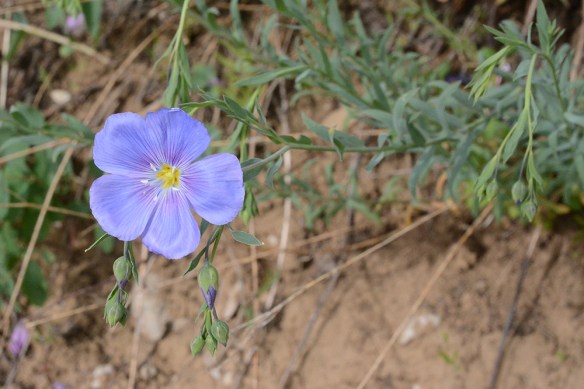
Fern-leaf Lousewort – Pedicularis bracteosa – 3-4’ plants have spires of yellow, hooded flowers. The pinnately divided, roughly toothed leaves look fern-like. Fading at the start of the trail, it is just flowering at the end. Meadows and open forest. C
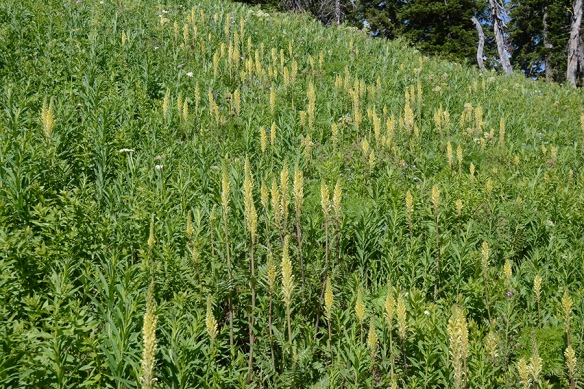
Colorado Columbine – Aquilegia coerulea – Elegant 5-parted flowers have flaring white sepals; the white tubular petals form 2”-long spurs trailing out the back; and many yellow anthers. Leaves are delicately dissected into 9 parts. These 24” plants are pollinated by moths and hummingbirds that can hover and extend their mouth parts deep into the spurs to reach nectar. In the process, the pollinator’s head/body is showered with pollen. When it visits another flower, the female sticky stamens tag the pollen. Consequently, 3 dry capsules with seeds will form. Moist montane. F
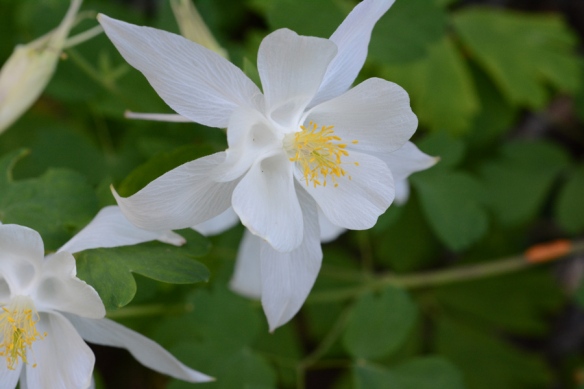
3. After a bit of forest, the trail goes along a drier slope:
Coiled Lousewort – Pedicularis contorta – grows along the trail edge and up the dry slope. This species rarely exceeds a foot in height, and often grows in groups of single-stemmed plants. The deeply divided leaves help in identifying it; compare to the more open, fern-like leaves of Bracted (or Fernleaf) Lousewort. ![]() Its creamy white flowers just fit the shape of particular pollinators, often bumblebees. A bee lands, vibrates its wings, and dislodges the pollen down the coiled “beak” onto its back. At the next flower, the female stigma is designed to reach pollen stuck between the head and thorax—where the bee can’t reach it. A very precise operation. The divided leaves help in ID. Drier locations. F
Its creamy white flowers just fit the shape of particular pollinators, often bumblebees. A bee lands, vibrates its wings, and dislodges the pollen down the coiled “beak” onto its back. At the next flower, the female stigma is designed to reach pollen stuck between the head and thorax—where the bee can’t reach it. A very precise operation. The divided leaves help in ID. Drier locations. F
![]()
Edible Valerian or Tobacco Root – Valeriana edulis – 3’ robust plants hold up candle-arbors of small white flowers, which then form fluffy fruits. A pair of 8-10” stem leaves are pinnately divided. The basal leaves are entire and elongate to 8-10”. The thick roots have a peculiar odor and taste, and to some noses stink like “sweaty socks”; however, it is nutritious sustenance with its large fleshy root, and it has been used by humans for food. F-C
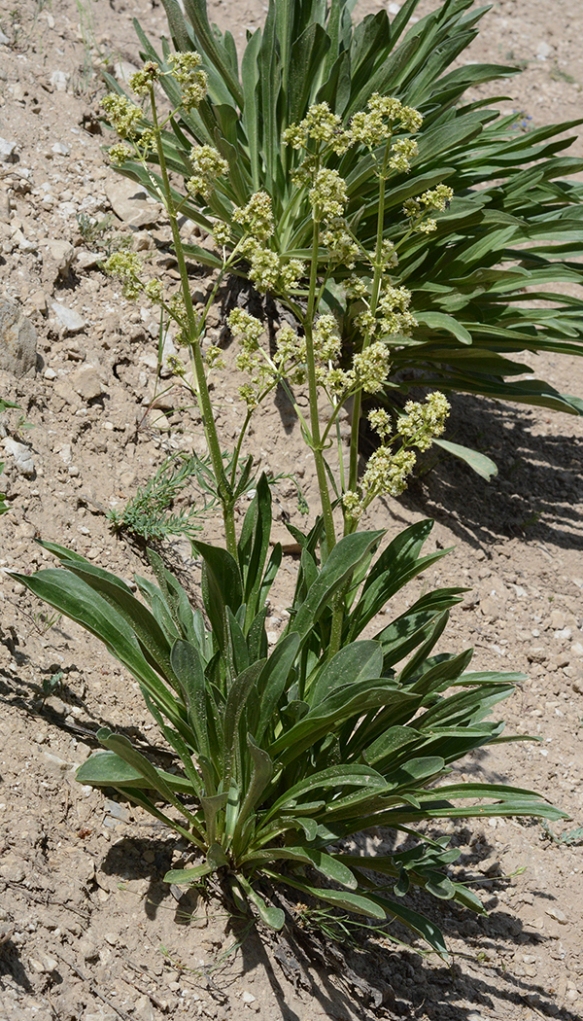
Western Sweetvetch – Hedysarum occidentale – The magenta pea-like flowers dangle from 12-18” stems, which will mature into uniquely flattened segmented pods. The leaves are pinnately compound with 1.5” elongate leaflets which have obvious veins. Plants form bright, untidy clumps to 3’ tall. More farther down the trail. Montane meadows. O
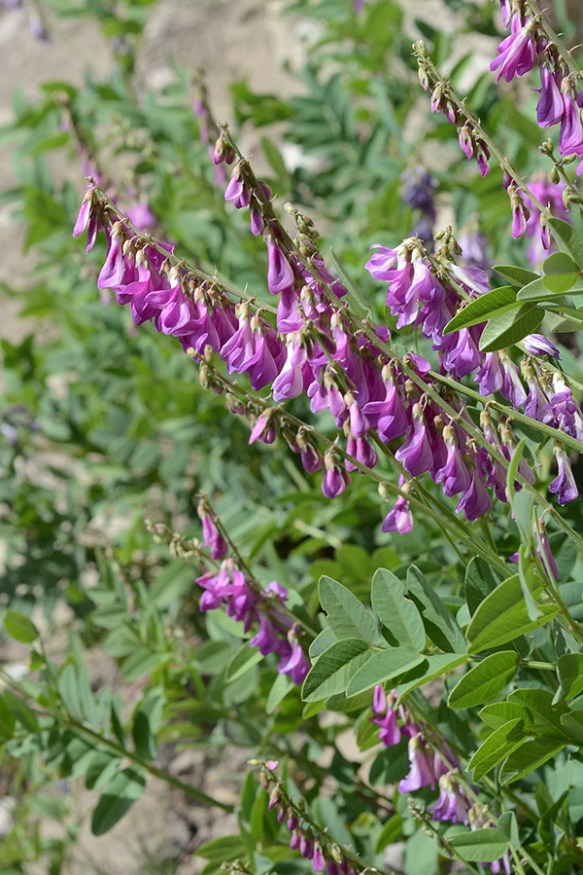
4. At the end of this stretch where the trail curves sharply to the right,
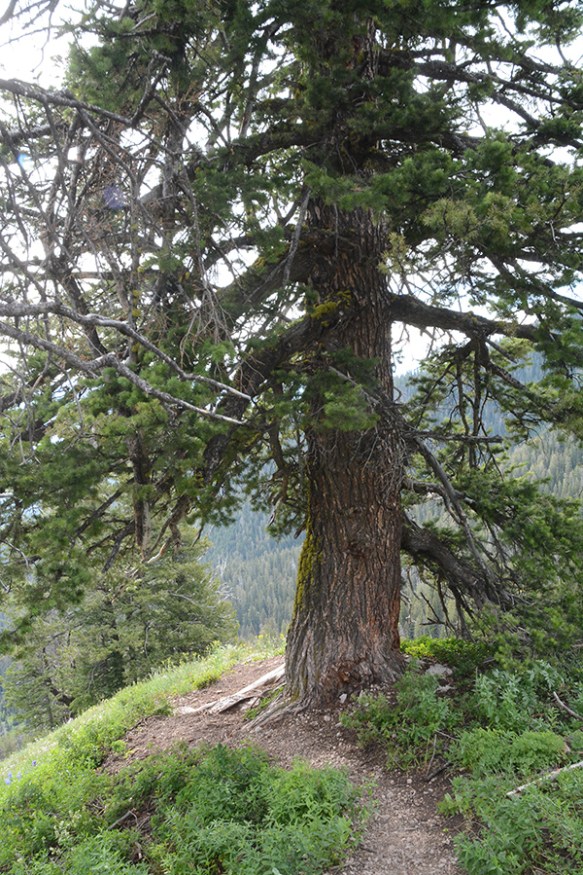
a large Douglas fir – Pseudostuga menziesii – stands out on the ledge to the left. These trees are more drought tolerant than spruce and fir. Their thick rugged bark helps it withstand low-intensity fires frequent in drier habitats. It is hard to reach the branches here, but the needles are similar to fir—soft and flat, but with a bit of a stalk to them. The dangling cones have distinctive “bracts” which some say look the tail and two back feet of a mouse diving for cover under each scale. O
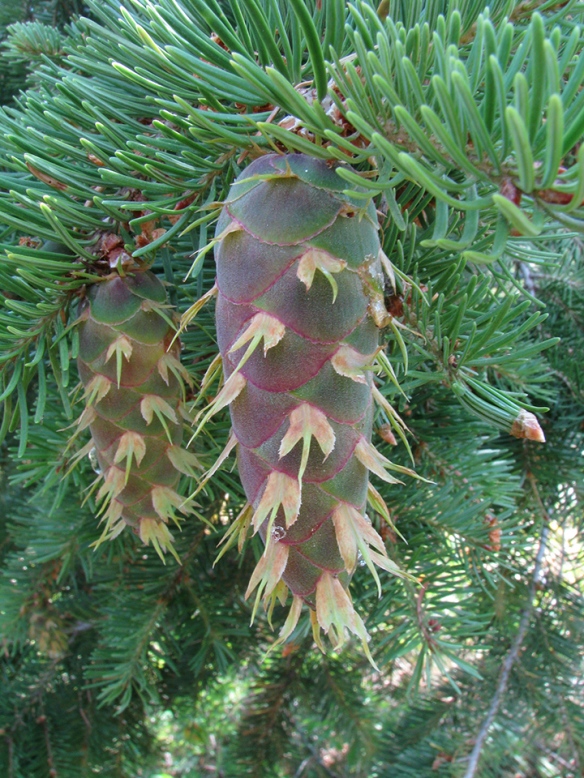
As you come around the corner, several new flowers attract attention on an extensive dry south-facing slope:
Blue Penstemons or Beardtongues – Look for stalks of blue tubular flowers and opposite leaves. The flowers have 5 short sepals and 5 fused petals that form a tube that flares out at the end with a 3-lobed lower lip. Four male stamens are curled up inside at the top of the tube. A fifth sterile stamen, more or less straight, lies at the base of the flower, and has hairs at the tip – giving the name “beardtongue”— say ahh!. Although penstemons are easy to ID to genus, species ID requires lots of fine details. We have identified these two for you:
Low – Penstemon humilis – small 8-12” tall, with deep blue flowers with a bit of pink at the base; dry slopes. O
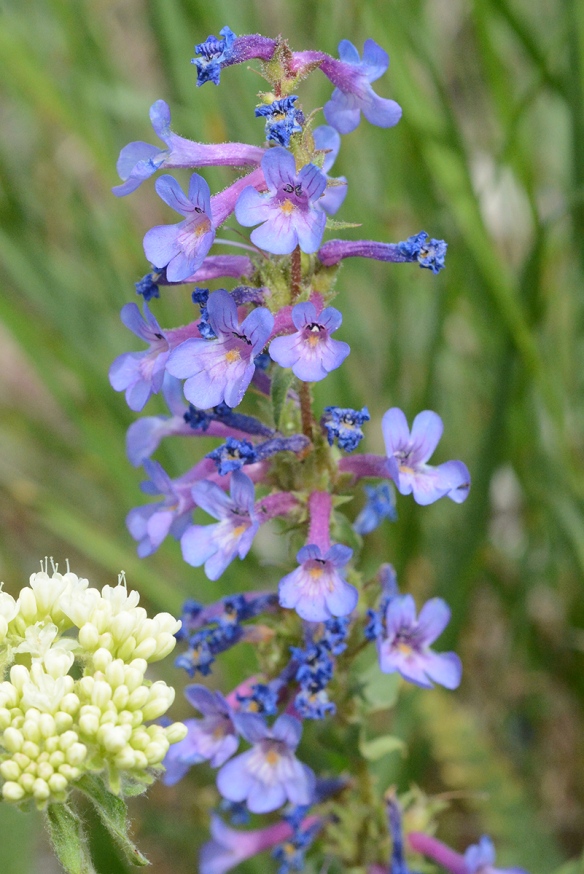 Wasatch – Penstemon cyananthus – mid-sized plants average 18-24” tall; Dry to moist slopes. F
Wasatch – Penstemon cyananthus – mid-sized plants average 18-24” tall; Dry to moist slopes. F
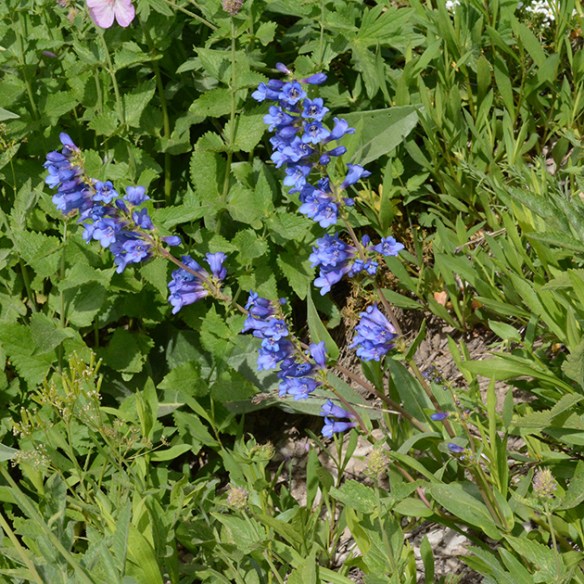
Paintbrushes – Castilleja spp. – can be confusing to identify in part because they hybridize and colors vary within a species. Many species are hemi-parasitic, their roots connect to roots of other plant species, such as lupines and sagebrush, and siphon extra nutrients to help them grow.
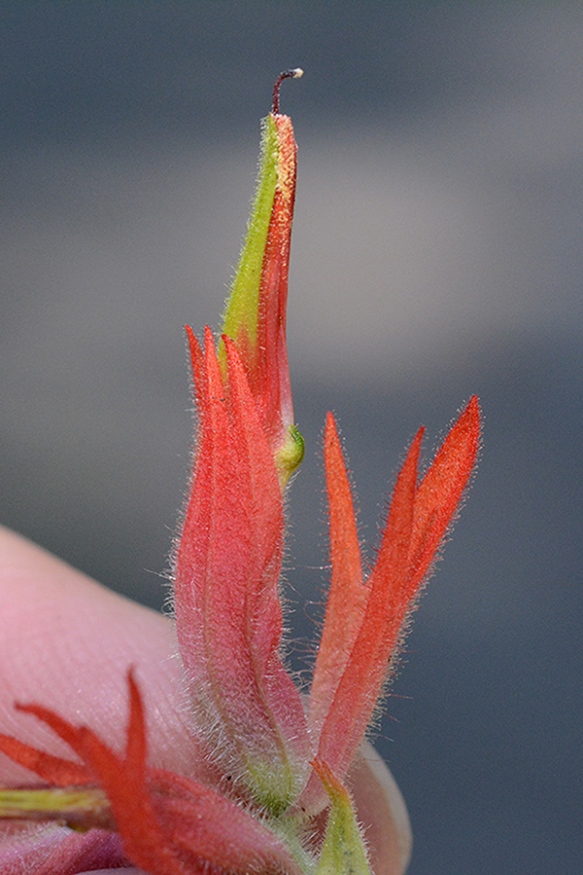
In general, the leaves alternate up the stems. Flowers have a unique design: flowers have a colorful bract (shown to right) under each flower. Each flower has a colorful calyx tube which is lobed. It surrounds the galea = tube of fused petals. The stigma and anthers are protected inside. Here the stigma sticks out from the green and red galea.
Here are some photos and tips to help ID three common paintbrushes.
Wyoming Indian Paintbrush – Castilleja lineariifolia – The Wyoming state flower has very slender often narrowly lobed leaves. Bracts and fused sepals are also pointed and narrow, and provide the orange color we see here. The petals are green and form a the elongate “galea” which leans way out between slits of the calyx tube. Look for the stigma protruding at the tip. These tubular flowers are pollinated by hummingbirds. Dry sites. F
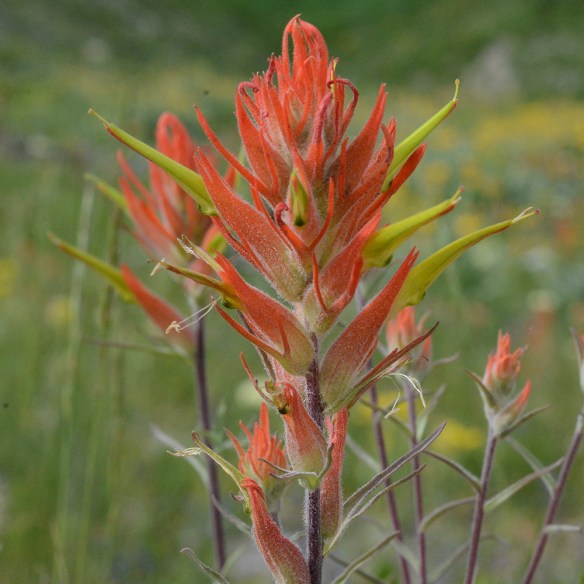
Scarlet Indian Paintbrush – Castilleja miniata – (we saw many on the first meadow slope, and more later) – is more true red here. The flowers are bunched together at the tops of often-branching stems 1-3’ high. The bracts and sepals tend to be wide, unbranched, and pointed. Along streams and meadows, aspen and coniferous forests. F
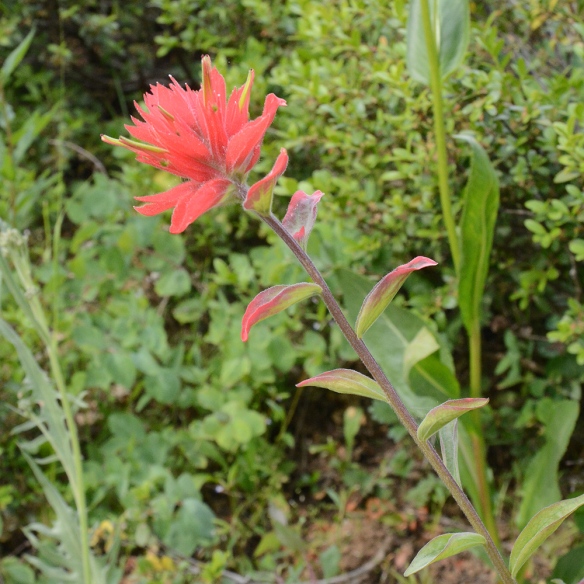
Sulphur Indian Paintbrush – Castilleja sulphurea – The overall look of the flowers is pale creamy yellow. The galea is often tucked behind the calyx and bracts. Stems 8-22” often branched. Subalpine to Alpine. F
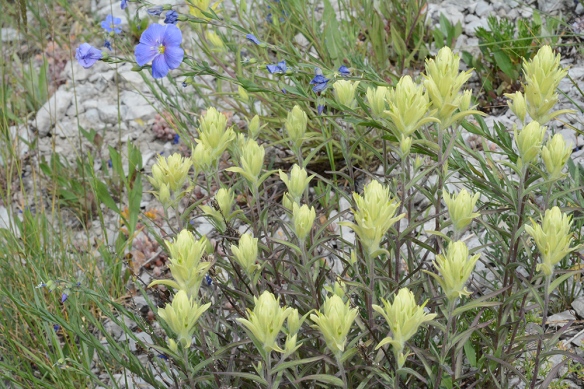
Sulphur Buckwheat – Eriogonum umbellatlum – is also common in sageflats and dry slopes of the valley floor. The pale-yellow to white flower clusters have a collar of leaves on 12” naked stems, and then small oval leaves that form a mat on the ground. Later the flowers will turn a rosy pink, and the dry fruits will be eaten by many small birds, such as juncos.
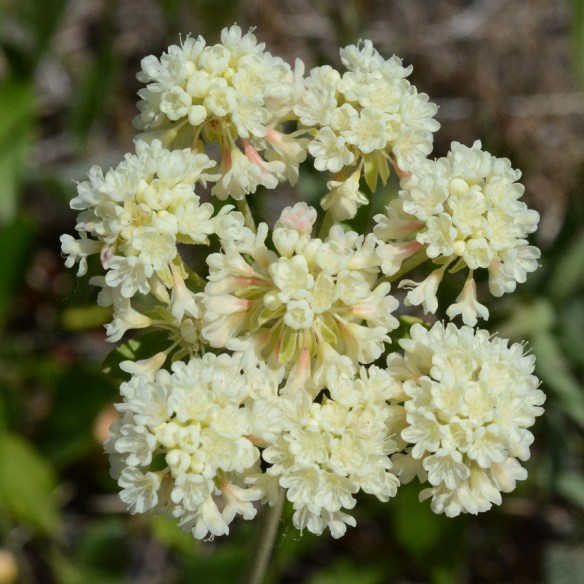
Scarlet Gilia – Ipomopsis aggregata – Bright red 1” tubular flowers are pollinated by hummingbirds. Hairy leaves are deeply dissected into linear segments that alternate up 1-3’ stems. Note, at first glance it might remind you of the Wyoming Paintbrush but the flowers here are much more symmetrical in design. Meadows and sageflats. F-C
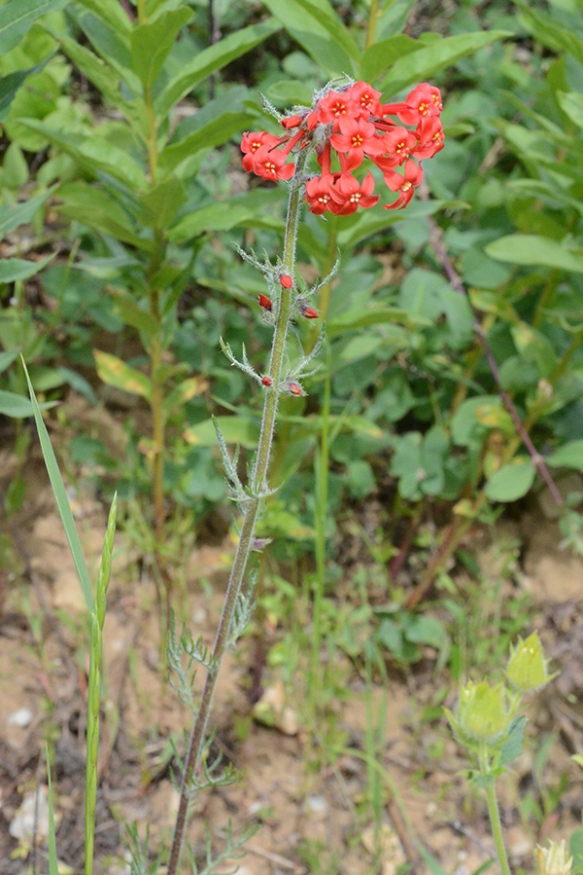
Silverleaf Phacelia – Phacelia hastata – is a lowly grayish plant with dingy blue flowers that is able to tolerate these dry rocky soils. At the end of the trail you will see its elegant relative. O
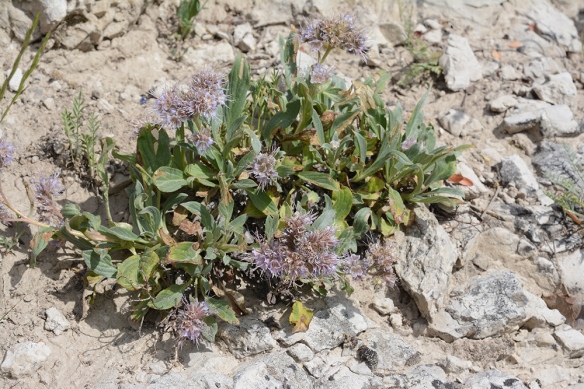
The Aster Family – Asteraceae – includes many familiar flowers. In this large family, many tiny flowers are arranged in “heads” surrounded by green bracts which together form what look like single flowers—a “composite” flower. Flower heads may have showy “ray” flowers that look like petals and small “disc” flowers that cluster tightly together in the center. Some genera have only ray flowers, others only disc flowers. Bracts and leaves are highly variable and help in ID. Fruits are achenes: a dry shell with only one seed inside. Think of your unshelled sunflower seeds. Some fruits are light and dispersed on a hairy “pappus” that floats them away; other achenes sit tight in the drying flower head until eaten by a bird or rodent.
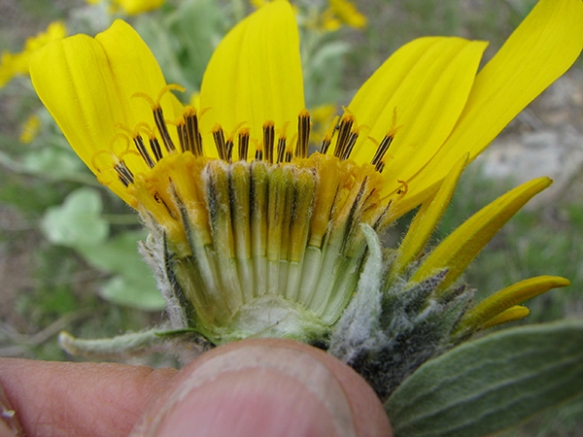
Arrowleaf Balsamroot – Balsamorhiza sagittata – is a prime example of a composite flower: It has a large yellow sunflower-like flower head with yellow ray flowers around many disc flowers that bloom over time. Green bracts surround the head. Note the foot-long silvery arrow-shaped leaves. This species flowered abundantly in the valley over a month ago, and is still blooming at these higher elevations. You will see more later. F
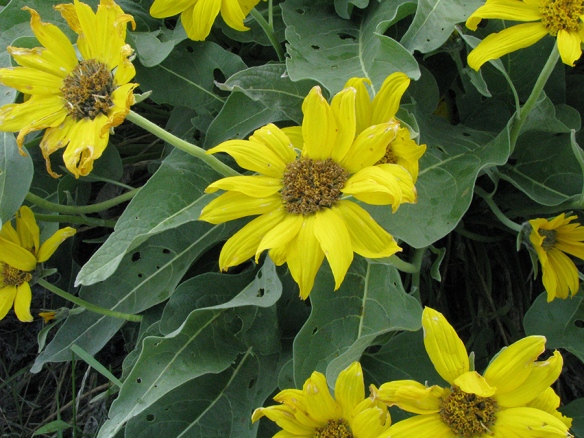
Two Little Sunflowers – Helianthella spp. – are also seen here and there along the trail and are common elsewhere. The One-flowered Helianthella – H. uniflora – has alternate to opposite elongate oval leaves and typically 1 flower at the top of each 2-3’ stem. O
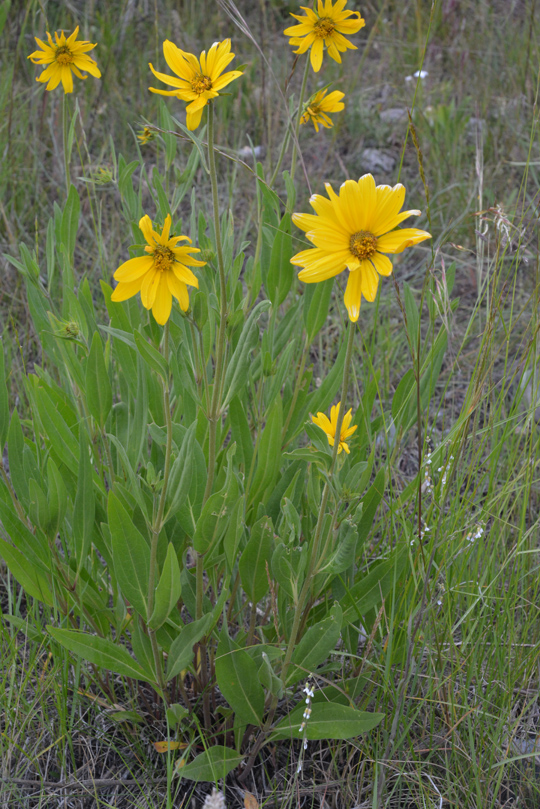
The Five-nerved Helianthella – H. quinquefolia – has larger heads 2” across which stand up up to 3-5’ and seem to stare right at you. The lower 6-8” leaves have 5 distinct veins. O
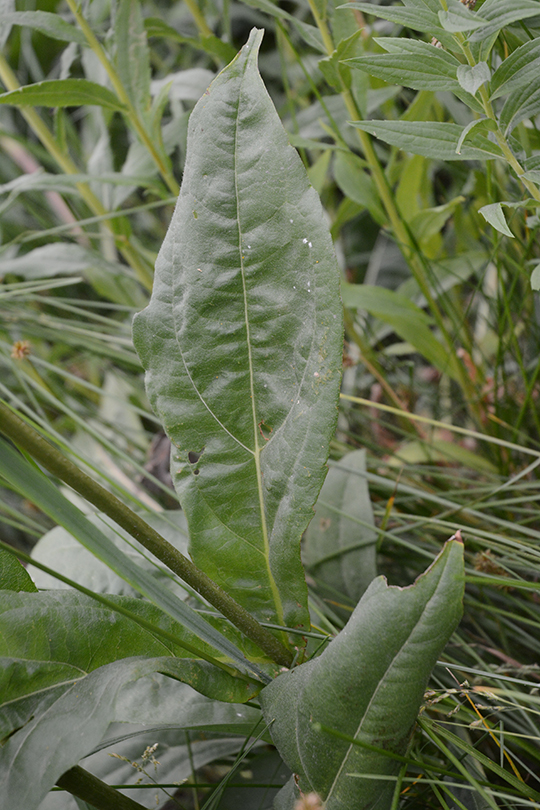
Comparatively, Tapertip Hawksbeard – Crepis acuminata – is not the most showy flower, but together its many small yellow flower-heads form a yellow bouquet on top of branching 12-18” stems. The flower-heads are like small dandelions with all “ray” flowers. Each head has only 5-10 ray flowers and the surrounding few bracts are smooth. Note the 8” grayish sword-shaped, leaves with sharp lobes are mostly at the bottom but also alternate up the stems. F on dry open slopes here and in sageflats.
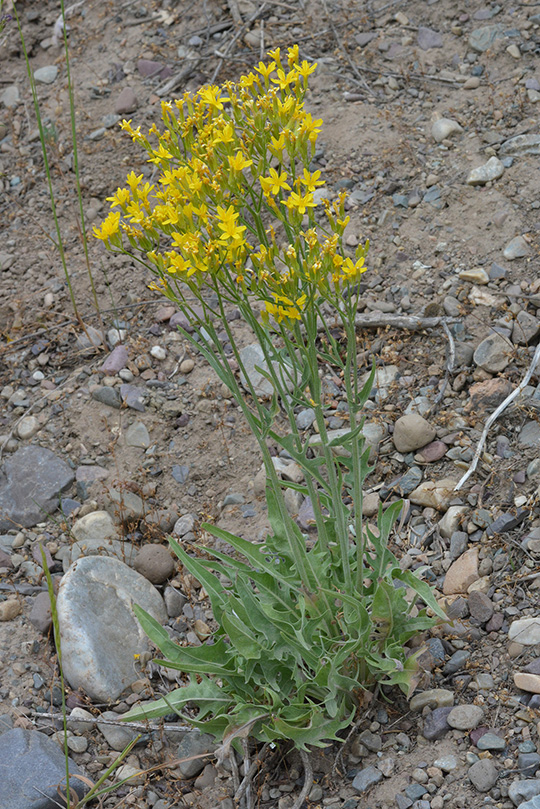
As the trail bends around and there is more moisture, there are places with magnificent mixes of species. These are good “review” spots.
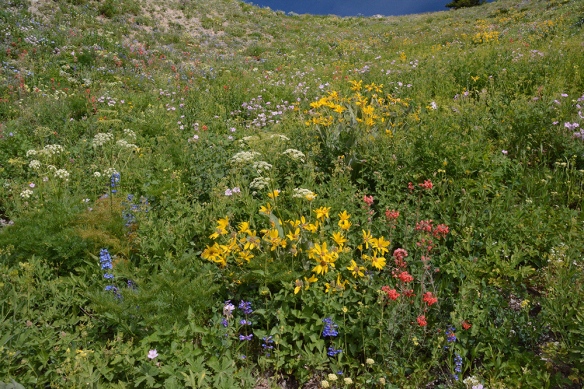
5 Continuing along the dry rocky slope: more “composites”
Dusty Maiden – Chaenactus douglassii – are grayish plants only 8-10” high. The whitish flower heads have only disc flowers, no ray flowers. The leaves are “pinnately” lobed and silvery hairy. The hairs help to reflect the intense sunlight and reduce evaporation, thus reducing water loss. R
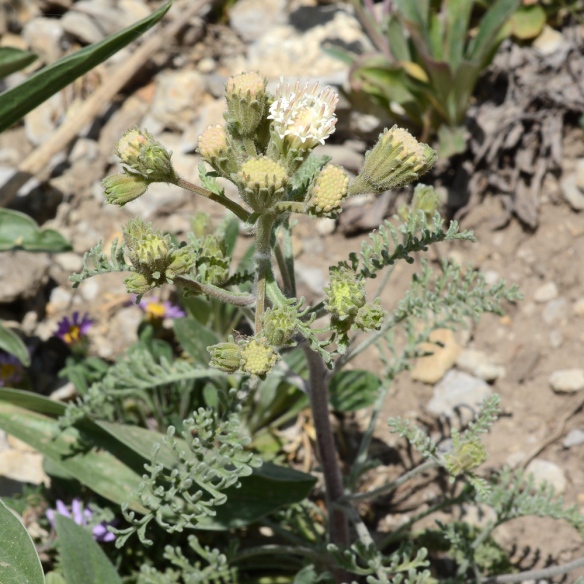
Rocky Mountain Groundsel – Packera streptanthifolia – has bright yellow flower heads with several wide ray flowers, and a center of disc flowers. The basal and stem leaves are highly variable as is the height. It shows up here and there along these dry slopes. O
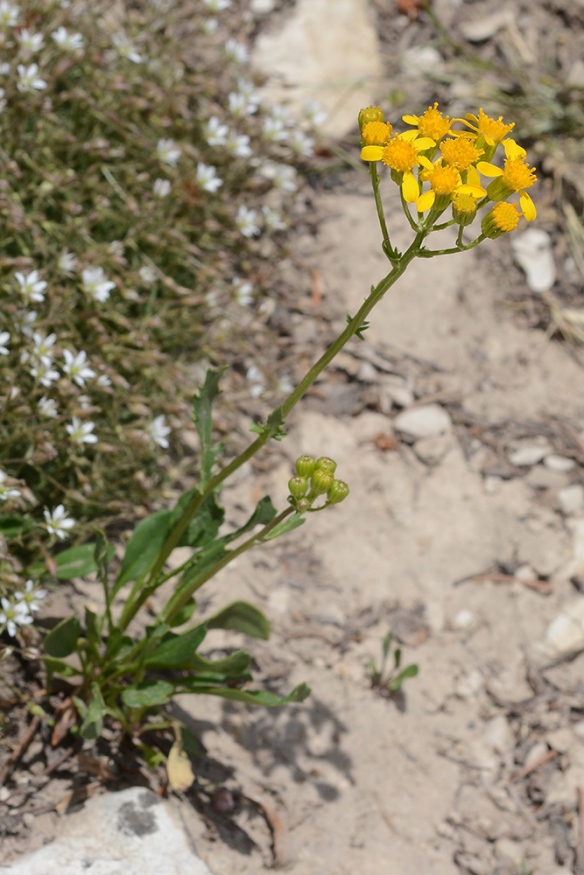
Rocky Mountain Goldenrod – Solidago multiradiata – has compact clusters of bright yellow-orange heads with many tiny ray flowers atop 1’ stems. Lower elongate leaves have stiff hairs along the edges of the petioles – a good ID character. Typically grows in dry rocky sites. O
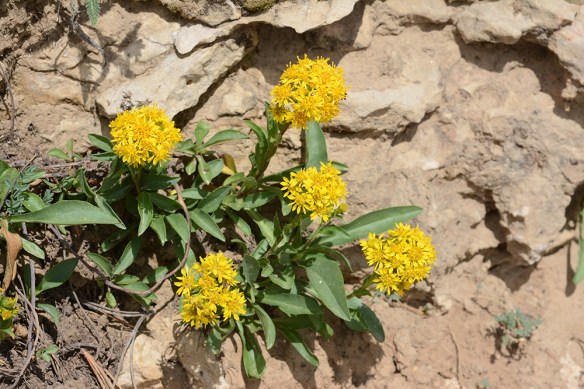
Mountain Townsendia – Townsendia montana/alpigena – can be overlooked as it is a very small plant that grows in 6” wide tufts and only 2-3” tall. This tiny aster-like plant has violet-blue flowers and yellow disc flowers. 1-2” leaves broaden toward the tip (obovate). Dry rocky, subalpine locations. R-O.
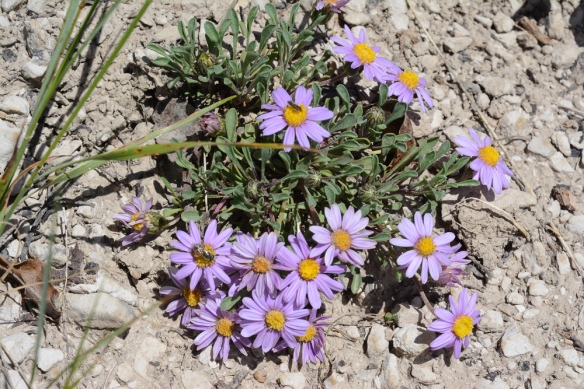
Another yellow composite that will soon be frequent along the trail: Houndstongue Hawkweed – Hierachium cynoglossoides – leaves are oblong-linear, with noticeably hairy stems—hairs stick straight out.
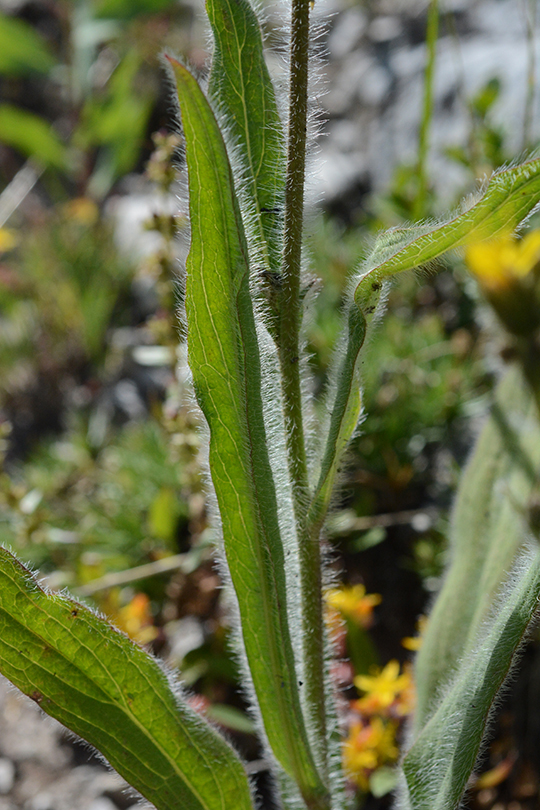
Plants will produce clusters of bright yellow ray flowers surrounded by blackish-hairy bracts. O
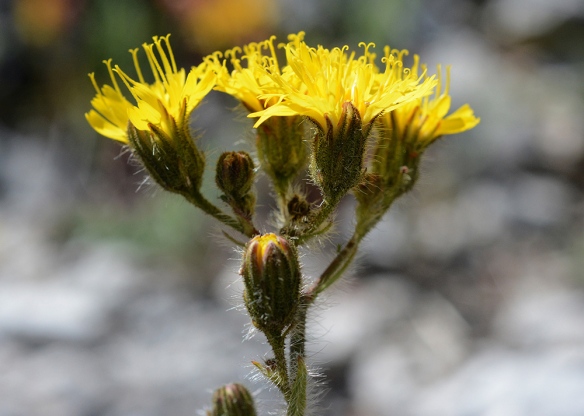
6. Just before you reach the access road and cell towers are two showy members of the Phlox Family.
The Phlox Family has fragrant tubular flowers with 5 flaring lobes. They are pollinated by long-tongued bees or butterflies that can perch on the wide petals and dip their mouthparts down to the bottom of the tubes to reach their reward of nectar. Leaves are opposite on the stem.
Nuttall’s Gilia – Leptosiphon/Linanthus nuttalii – White very fragrant flowers cover foot-wide mounded plants. Leaves appear needle thin and whorled around the delicate 12” tall stems. Actually they are deeply dissected opposite leaves. Grows on rocky, usually sunny montane slopes. O, fading
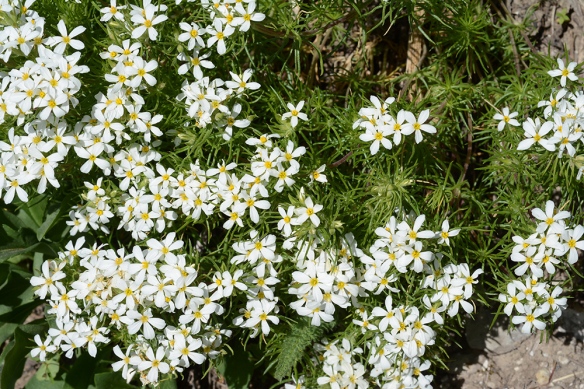
Many-flowered Phlox – Phlox multiflora – A reminder of spring in the valley, mats of tubular white flowers waft a wonderful scent. Opposite, “awl-shaped” leaves are about 1” long forming dense mounds. Dry open places. O – most faded here.
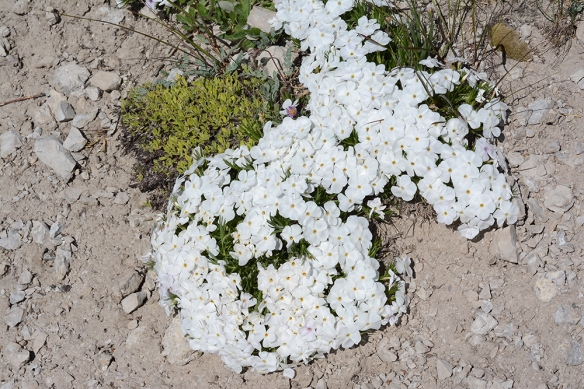
After the Cell Towers:
The open meadow has many of the same flowers as before: Balsamroot, Flax, Edible Valerian.
Cinquefoils – Potentilla spp: – become more noticeable. Several cinquefoils are frequent along roadsides and meadows. They all have 5 green pointed sepals, 5 bright to pale-yellow to whitish petals, and compound leaves—some are pinnately compound, others palmately divided–found at the base of the plant and alternating up the stem. Most are very adaptive plants and they can hybridize: They can be confusing to ID! You don’t have to bother with the particular names—just “cinquefoil” is fine. For the avid, here are three common ones found along this trail.
Tall (Sticky) Cinquefoil – Potentilla arguta –stands 2-3’ high, has “pinnately-divided” leaves at the base and up the stem, sticky hairs all over, and pale yellow (to white) flowers that are clustered fist-like at the ends of stiff upright stems. F
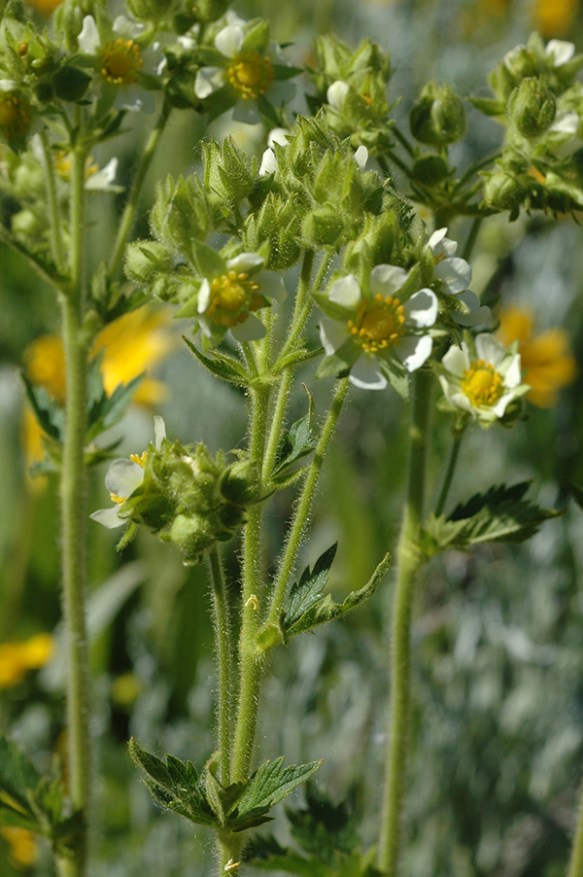
Gland Cinquefoil – P. glandulosa – is very similar and at times hard to distinguish from Tall cinquefoil. However, the flowers tend to be on branches that are less stiffly upright. O
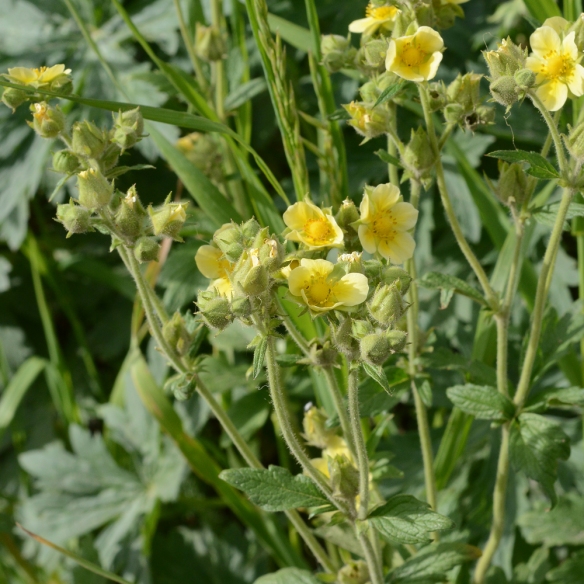
Slender Cinquefoil – Potentilla gracilis – has wide-spreading sprays of cheerful yellow flowers. The leaves are “palmately”-divided into 5-7 leaflets, mostly found at the base of the stem. This is a highly variable, common, and adaptable species. F
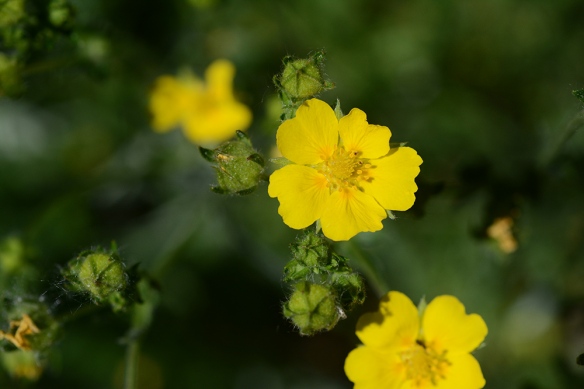
7. Entering Palisades WSA: Note the sign is posted on a fir tree.
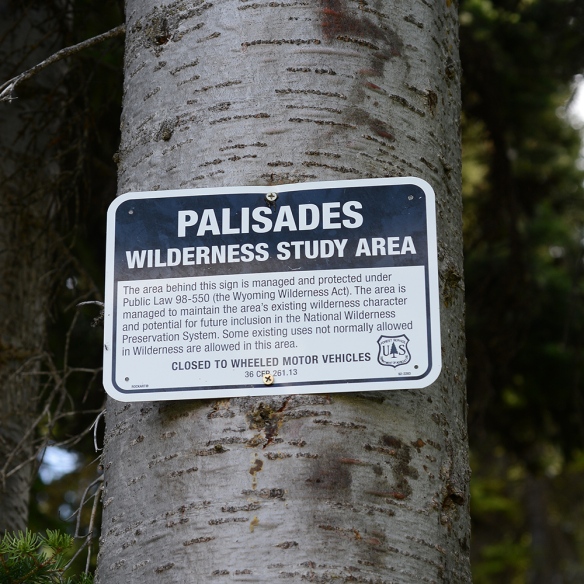 You will continue through the small patch of spruce/ fir forest to more meadow with many of the same species as before. Here we add:
You will continue through the small patch of spruce/ fir forest to more meadow with many of the same species as before. Here we add:
Orange Mountain Dandelion – Agoseris aurianticum – looks like a large orange dandelion with its many ray flowers at the top of 8-12” stalks surrounded by elongate basal leaves. O

You may see also the more common yellow Mountain Dandelion – Agoseris glauca. O

Thickleaf Groundsel – Senecio crassulus – is another composite that can be common in mountain meadows ranging from 1-3’ tall. Bracts are all the same length, smooth, and black-tipped and surround the several strap-like yellow ray flowers and many disc flowers. The base of the elongate pointed leaves “clasp” the stem. The fruits will have a feathery white “pappus” which will help the seeds disperse in the air, like a dandelion. O
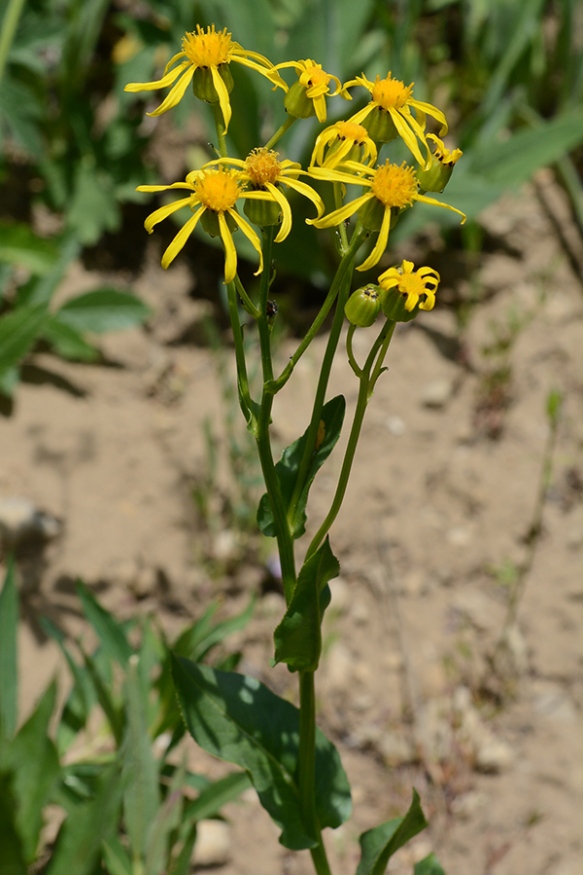
Tall Larkspur – Delphinium occidentale– is sending up 4-5’ spires of blue to white flowers. It is a lean relative to the profuse ornamental Delphinium/larkspur blooming in many Jackson Hole gardens right now. Look for its relative Low Larkspur farther along to examine how the flowers work. O

Sugar Bowls – Clematis hirsutissima – is often nicknamed “Dr Seuss plant” for its clusters of unruly fluffy fruits on top of 2’ tall 3’ wide plants.
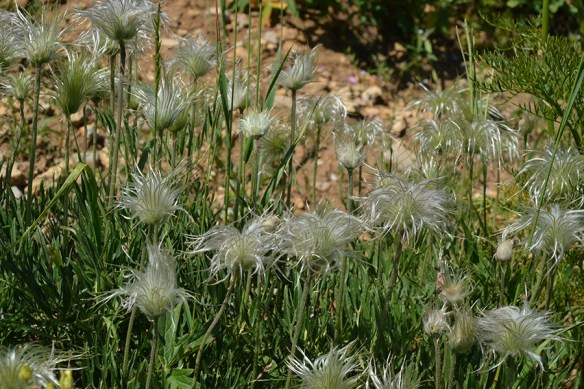 These fruits come after the early blooming flowers mature. Flowers have four, 1-2” long violet-blue sepals (there are no petals) that form an elongate, thickened, bell-shaped flower.
These fruits come after the early blooming flowers mature. Flowers have four, 1-2” long violet-blue sepals (there are no petals) that form an elongate, thickened, bell-shaped flower.
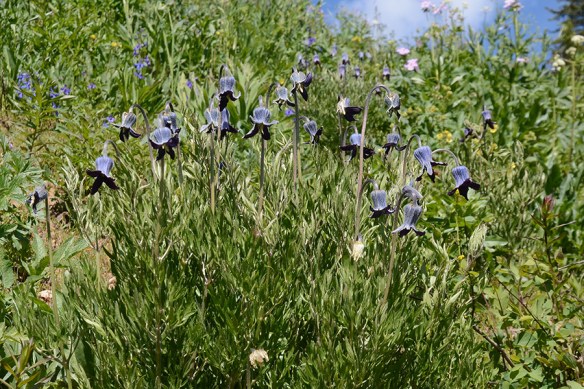 The large opposite leaves are dissected into elongate leaflets. Sugar Bowls are considered a harbinger of spring in the valley, yet it is blooming at end of the trail now! O
The large opposite leaves are dissected into elongate leaflets. Sugar Bowls are considered a harbinger of spring in the valley, yet it is blooming at end of the trail now! O
8. Enter another large patch of old growth spruce/fir forest. Note the downed trees that remain intact for years due to the cold dry climate. Little grows in the deep shade. A large log serves as a handy place to rest, before you continue you up and on to more meadows!
9. Got the blues! This meadow has a great selection of blue flowers:
Jessica Stickseed – Hackelia micrantha – looks like a tall for-get-me not. Delicate clusters of sky-blue flowers with yellow centers have much appeal. Plants grow to 3-4’ feet tall with 4-6” elongate leaves, mostly at base, but also alternating up the stem. However, its barbed fruits which stick to clothing and fur are less welcome. The fruits help spread the seeds down the trail. C
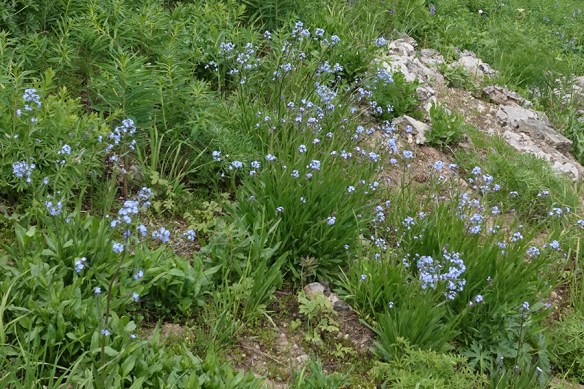

Low-Larkspur – Delphinium nuttallianum – Another plant that bloomed almost 2 months ago in the Valley, there are still patches here. The deep blue flowers have 5 flaring blue sepals—one of which forms a spur; 2 whitish petals streaked with nectar guides that stand up, 2 hairy petals that drape down. This array guides pollinators into the flower past the mop of yellow anthers, to reach down to where there is a reward of nectar. They fly off with a dusting of pollen on their backs. If pollen is successfully transferred to another flower, 3 upright seed capsules will form. F
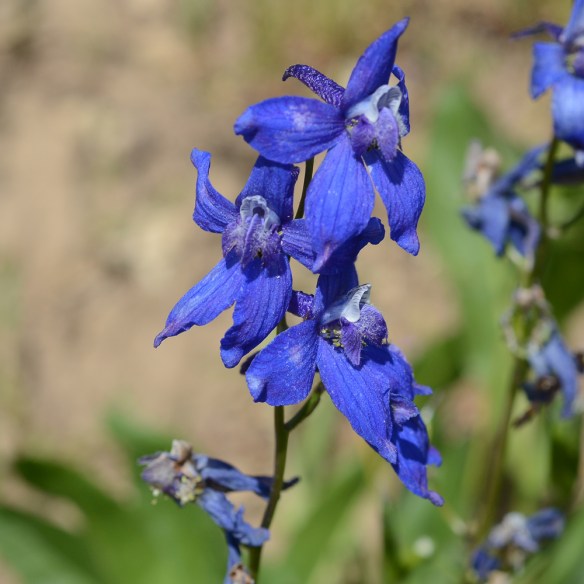
Mountain Bluebells – Mertensia ciliata– Dangles of pink to blue “bell” flowers at the tips of 3-4’ high arching branches. Oval 2-3” blue-green leaves alternate up the stems. Flower color goes from pink to blue when ready for pollinators. Found in moist meadows and seeps. LA.
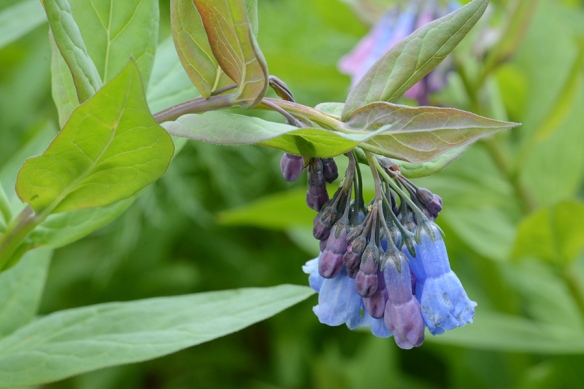
Two blue aster-like species have begun to bloom along the trail. They are actually Fleabane Daisies – Erigeron spp. –flowers have many blue to whitish narrow ray flowers and the bracts to their flower heads are pretty much all the same length. Keep an eye out for them.

Showy Fleabane – Erigeron speciosus – is probably the most common of the larger fleabanes in the area, growing at moderate and higher elevations. Many narrow ray flowers of a violet-blue color, ofen 2’ or more high. Leaves are shiny and they often have slightly wavy margins. O

Wandering (Subalpine) Daisy – Erigeron peregrinus – This showy daisy has light violet ray flowers that tend to be wider and larger than those of Showy Fleabane. They grow up to 2’ tall, and along this trail they favor the edges of forest where both sun and moisture is available. O

Late melting snow patch 100’ before the Lithium Trail. Wind has deposited the snow into a heap over the winter, and the deep shade of the forest keeps it from melting very early, so you can still find the first flowers of spring here.
Spring Beauty – Claytonia lanceolata – bloomed in the valley in April and is just now blooming as the snow melts here. R
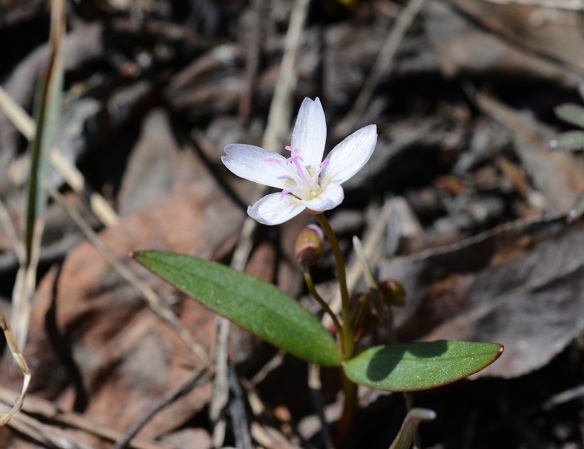
Snow Buttercup – Ranunculus adoneus – has glossy yellow petals which reflect sunlight. Weak stems are about 6” high and the leaves are divided into delicate long segments. R

10. Meadow near End of Trail:
Amidst the yellow stalks of Fern-leaf Lousewort is Mountain/Alpine Sorrel – Rumex paucifolius. Plants stand 1-1.5’ tall, with a cluster of 6-8” elongate leaves around the base and shorter leaves alternating up the stems. Leaves have a tangy flavor from oxalic acid. Flowers are very small but in numbers produce an intense reddish hue. Male and female flowers are on different plants. Different species of sorrels are used for food and/or medicine. LA
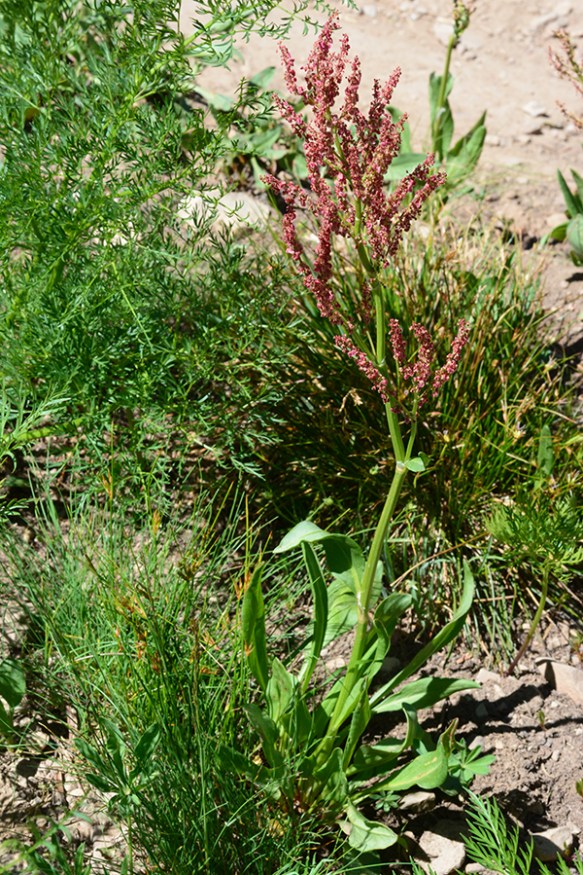
Enjoy the view south into the heart of the Palisades WSA.
Looking across Mosquito Creek, you can see many of the area’s high peaks from Wolf Mountain to the south to Observation, Palisades, Starvation, and other high points to the west. The plant communities in the area include some that are not common in this part of Wyoming (curl-leaf mahogany; bigtooth maple). The area’s size, diversity, and beauty all contribute to its status as a candidate for wilderness.
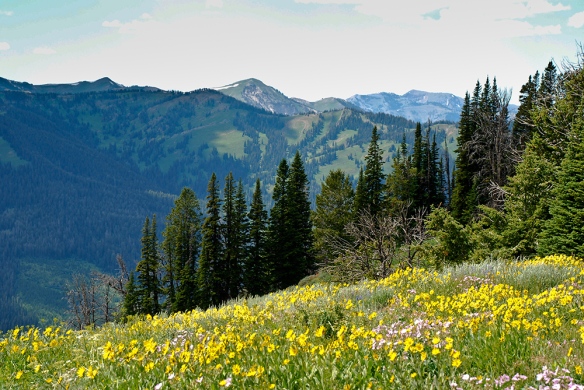
11. To the summit of Mt. Elly:
Bear left up a short, steep slope through spruce and fir, and dying white bark pine trees.
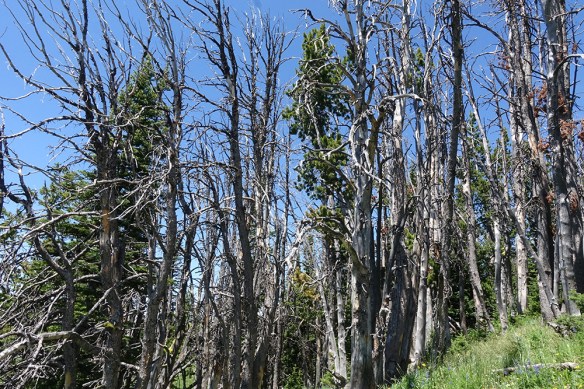
White-bark pine – Pinus albicaulus – is a high-elevation species with 5 needles/cluster and tough 2-3” cones with large nutritious seeds. Clark’s Nutcrackers are able to dislodge them from the cones with their strong beaks and can stash 1000s of seeds each year, remembering where they placed them in holes on mountain sides. They retrieve this highly nutritious food to survive the winters. However, some seeds are left to sprout. Both bird and pine depend on each other. Climate change is affecting the viability of this keystone species as pine bark beetles and pine blister rust have now spread into the warming high elevations. R
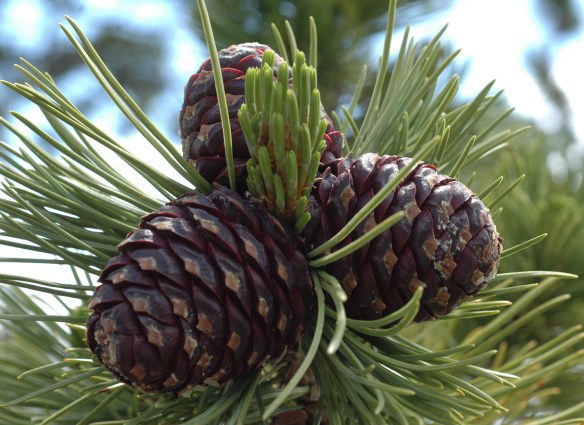
Silky Phacelia – Phacelia sericea – is tucked into the shade. It is an elegant plant that stands up tall to 1-2 feet. Stems are trimmed with coils of royal purple flowers, each with elongate, gold tipped anthers. The leaves swirling around the base of the stem are neatly lobed. R
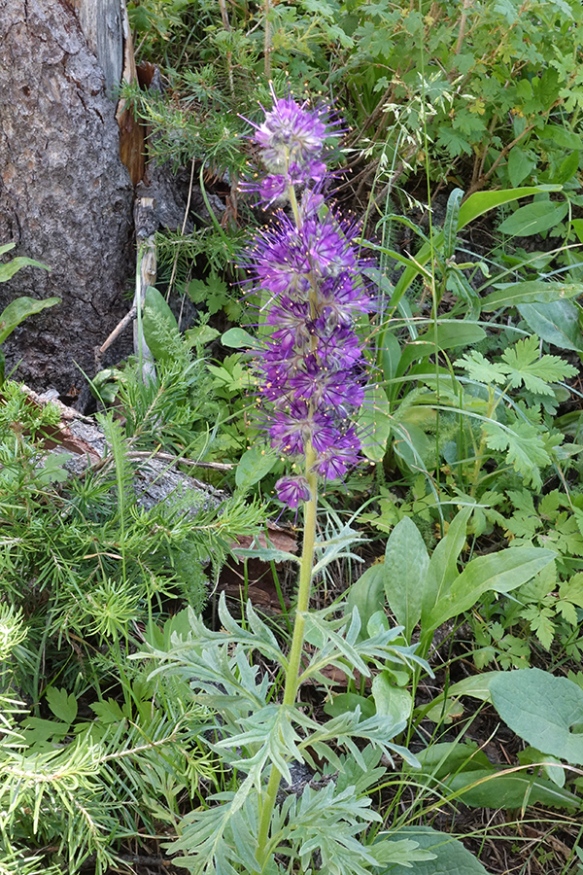
Dry south facing slope: Sagebrush is intermingled with several common species found in the valley below:
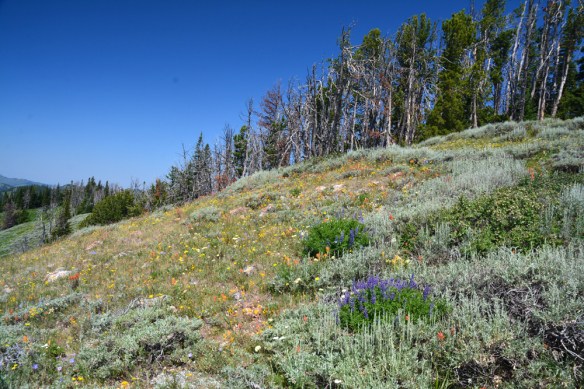
Along with Sulphur Buckwheat, Scarlet and Wyoming Paintbrushes, and Slender Cinquefoil, look for
Ball-headed Sandwort – Eregomone congesta – Needle-like leaves are paired up the 12” thin stems which together form delicate clumps. Each stem is topped with several ¼” white flowers, each with five sepals and petals, congested together. Dry sageflats and slopes. Here scattered on dry slopes. LA

Lance-leaved Stonecrop – Sedum lanceolatum – has small pudgy pointed leaves that alternate up the 4-8” stems or form rounded clusters at the base or axils. Flowers with 5 bright yellow petals. The succulent leaves along with a different metabolic pathway help them survive on rocky or desert sites. LA on rocky sites.

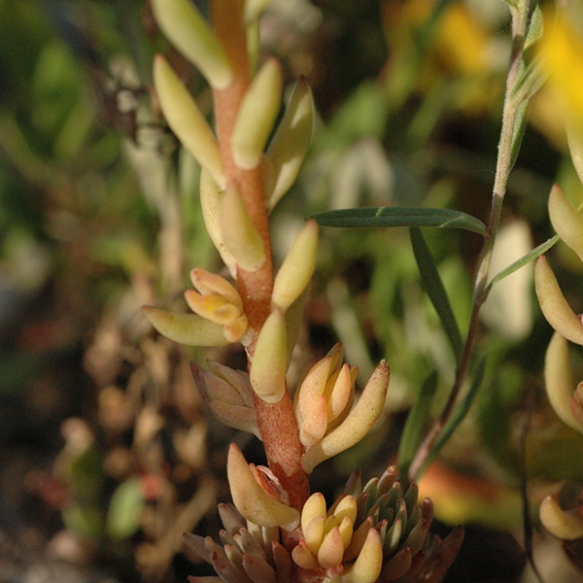
On the way back enjoy the abundance of the many different flowers and the large and small critters that depend upon them. Remember the freedom provided by the space and wildness of the Palisades Wilderness Study Area.
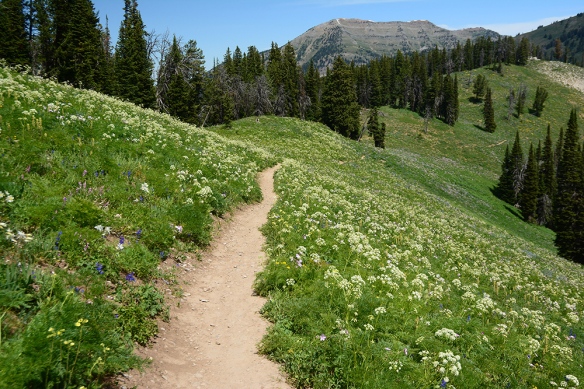
We welcome comments, corrections, and shared adventures.
Frances Clark and Susan Marsh, Teton Plants
Teton Plants is a chapter of the Wyoming Native Plant Society. We are all volunteers who enjoy sharing the delight and intrigue of wild plants through field trips, lecture programs, and postings. See past “What’s in Bloom” postings for more information on plants throughout the seasons. To be placed on our email list or to get a list of the plants seen along this trail contact us at tetonplants@gmail.com
Also, contact Wyoming Wilderness Association for more on the Palisades Wilderness Study Area, and the other work they do. WWA can also provide the list of plants on the trail. https://www.wildwyo.org/
